Volunteer Gliding Squadron
A Volunteer Gliding Squadron (VGS) is an aircraft squadron of the Royal Air Force (RAF) which provides flying training in glider aircraft for Royal Air Force Air Cadets. All current operational Volunteer Gliding Squadrons operate a sole type of aircraft, the Grob G103A Twin II Acro, a conventional winch-launched tandem-seat sailplane known by its British military designation, Viking T1.
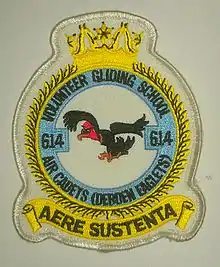
Since 2014, the squadrons operate under No. 2 Flying Training School, which was newly reformed for this purpose at RAF Syerston in Nottinghamshire, within No. 22 (Training) Group of the Royal Air Force.[1] The ten operational squadrons, along with the Royal Air Force Central Gliding School, are standardised annually by the Royal Air Force Central Flying School. Under the Air Cadet Organisation prior to 2010, Headquarters Air Cadets, based at RAF Cranwell, retains administrative support.
Each VGS is made up of entirely volunteer staff. They are headed by a Officer Commanding and several executives, who are appointed by a Cadet Forces Commission in the Royal Air Force Air Cadets (RAFAC).[2][3] Instructors are a mixture of regular Royal Air Force / Royal Navy / British Army personnel, reservists, RAFAC personnel, retired Royal Air Force pilots, Civilian Gliding Instructors and Flight Staff Cadets.
History
Gliding was first introduced for the Air Defence Cadet Corps in 1939, but formally became part of official training with the Air Training Corps in 1942. From 1946, 87 Gliding Schools came under the Reserve Command.
Command
Initially, the gliding schools were established under RAF Reserve Command, later to become RAF Home Command. In 1955, RAF Flying Training Command took over the responsibility and amalgamated them into 27 gliding schools under Headquarters Air Cadets. At the same time, the gliding schools were renumbered with three-digit numbers, the first two digits being the parent Home Command Group (Nos. 61, 62, 63, 64, 66 or 67).[4] In 1968, RAF Training Command was established, incorporating Flying Training Command. In 1977, Training Command was absorbed into RAF Support Command, and then moved into Personnel and Training Command on its establishment in 1994, before being subsumed into Air Command in March 2007, where the gliding schools are today controlled by.
Under Air Command, the chain of command for these units is through No.22 (Training) Group. On behalf of Air Officer Commanding No.22 (Training) Group, the Volunteer Gliding Squadrons and the Central Gliding School are the responsibility of the officer commanding No. 2 Flying Training School.
Formation of the Central Gliding School
Formulated in 1946, the Home Command Gliding Instructors School (HCGIS) was established in 1949 at RAF Detling to train Qualified Gliding Instructors (QGI) for the gliding schools. With the disestablishment of Home Command, HCGIS was split into two Gliding Centres to accommodate the gliding schools in the north and south of the United Kingdom. A further reorganisation amalgamated the Gliding Centres into the Central Gliding School in 1972 at RAF Spitalgate, where it was renamed the Air Cadet Central Gliding School (ACCGS) in 1974. In 2009, following the formal approval of the CGS unit badge, the Air Cadet Central Gliding School was renamed the Royal Air Force Central Gliding School, and in 2010, restructured under No.1 Elementary Flying Training School (1EFT).
The CGS is commanded by a Wing Commander RAF, who also acts as OC Flying for RAF Syerston. The Chief Instructor is a Squadron Leader RAF. The examiners of the CGS are Flight Lieutenant RAFR and Squadron Leader RAFR officers, however all future appointments shall be Royal Air Force Volunteer Reserve (Training Branch) RAFVR(T) commissions.
From wood to GRP
The Royal Air Force chose to re-equip the ageing fleet with the first of the modern glass-reinforced plastic (GRP) gliders, and in 1983 acquired an initial batch of ten Schleicher ASK 21, named Vanguard TX1. The first examples were delivered to the Air Cadet Central Gliding School (ACCGS) at Syerston in time for the new Instructors' courses to take place. The first VGS to equip with these was 618 VGS at RAF West Malling. Instructors from this unit were converted to the new training syllabus, and began flying the type during July and August of that year. The first Vanguard TX1s were delivered to West Malling in July 1983, and training for cadets began in August the same year.
After the initial ten were delivered, Alexander Schleicher was unwilling to open a production line for the Ministry of Defence (MoD), as they did not want to sideline their civilian market. A tender was issued, and Grob Aerospace was awarded the contract to supply one hundred Grob G103A Twin II Acro gliders. The RAF named the military variant as the Viking T1 in Air Cadet service.[5] A single specimen was delivered to Slingsby Aviation in the UK for fatigue life testing.
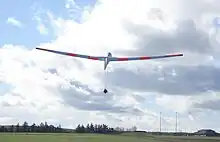
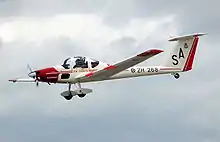
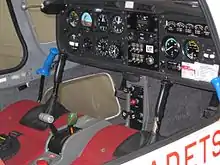 Vigilant T1 motor glider cockpit
Vigilant T1 motor glider cockpit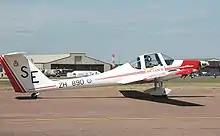 Vigilant T1 at the 2010 Royal International Air Tattoo, RAF Fairford, Gloucestershire
Vigilant T1 at the 2010 Royal International Air Tattoo, RAF Fairford, Gloucestershire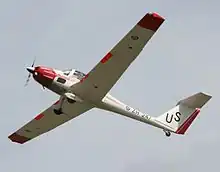 Vigilant T1 at Farnborough Airfield during the 2008 Farnborough Airshow
Vigilant T1 at Farnborough Airfield during the 2008 Farnborough Airshow
Introduction of motor gliders
The Slingsby Falke motor glider, known in the Royal Air Force as Venture T1, was trialled at the Air Cadet Central Gliding School (ACCGS) at RAF Spitalgate from 1971 to 1973. Ten Glider Schools (GS) were first issued with the T1 variant in 1977, but were quickly upgraded with the TX2. The development of many sites and closures of many RAF aerodromes put strain on many conventional VGS. Further GSs were allocated with the TX2s. In 1991, the Venture TX2 was replaced with the Grob G-109B motor glider, Royal Air Force name Vigilant T1. Originally designated the Vigilant TX1, the glider designation 'X' was dropped due to its change of role.
Disbandment of the competition fleet
In 2000, Air Cadet Organisation (ACO) Chief of Staff (COS) Group Captain Mike Cross announced the sale of the Valiant TX1 and Kestrel TX1 fleets. This concluded the RAF's many successful years competing in national gliding competitions and setting world records.
Schools to squadrons
Initially established as Gliding Schools (GS), they were all re-designated Volunteer Gliding Schools (VGS) in 1978. In 2005, following a decision by the Royal Air Force Board, they were again renamed Volunteer Gliding Squadrons, thus keeping their VGS abbreviation.
Air Cadets to Royal Air Force
Following the restructure in 2005, a further reorganisation was initiated in 2010 by Air Officer Commanding (AOC) 22 Group RAF. On 1 April 2010, Command and Control, together with the responsibility for supervision and regulation of the Central Gliding School and twenty-seven Volunteer Gliding Squadrons, was moved from the Air Cadet Organisation (ACO) to the Directorate of Flying Training (DFT) under No. 1 Elementary Flying School RAF (No1 EFTS). A further restructure in December 2011 saw No1 EFTS absorbed into No. 3 Flying Training School (3FTS), together with a gliding branch of the school developed from No1 EFTS.
Extended pause and reinvention
With the introduction of the Grob Prefect T1 (an update of the Tutor T1, notably with a glass-cockpit and retractable undercarriage) into UK Military Elementary Flying Training, the RAF's fleet of Grob Tutor T1 faced a reduction against the Vigilant T1 motor glider, due to competing roles for powered flying for Air Cadet. 22 Group decided the Vigilant T1 had to be withdrawn, to protect the Air Experience Flights (AEFs), which are operated by volunteer retired RAF officers, despite the Vigilant T1 motor glider's more capable role and potential to enable cadets solo flying. In April 2014, all Air Cadet Organisation gliding was abruptly halted under the auspices of 'airworthiness concerns'. Maintenance records managed by contractor Serco were found to be in disarray.[6] Flying resumed to a limited extent in 2016.[7]
In March 2016, a major restructuring of Air Cadet gliding and flying was announced,[8] resulting in the disbanding of fourteen Volunteer Gliding Squadrons, significant reduction of the Vigilant motor glider, a regional focus of remaining Viking squadrons, and an increase in Tutor Air Experience Flight (AEF) flying. With the Vigilant due to be withdrawn from service in 2019, its retirement was brought forward to May 2018.[7] Two new AEF squadrons will be formed.
A review of the Defence Estate, published in November 2016, confirmed the disbandments announced in March, and gave estimated dates for disposal of several sites.[9]
Despite the Vigilant T1 motor glider fleet being declared un-airworthy and uneconomical to return to the air, all 63 grounded Vigilant T1 were sold to Hampshire-based charity Aerobility, which works with people with disabilities and injured ex-military personnel. A number would be modified and refurbished for use by the charity, while the majority would be sold to support the charity.[10]
Current glider units
Central Flying School
- HQ, No. 2 Flying Training School RAF — RAF Syerston, Nottinghamshire
- Central Gliding School — RAF Syerston, Nottinghamshire
Conventional glider VGSs (Viking)
- 611 VGS — RAF Honington, Suffolk
- 615 VGS — RAF Kenley, Greater London
- 621 VGS — RAF Little Rissington, Gloucestershire
- 622 VGS — Upavon Station, Wiltshire; 6 gliders (previously 7)
- 626 VGS — Predannack, Cornwall
- 631 VGS — RAF Woodvale, Merseyside, formerly 186 GS
- 632 VGS — RAF Ternhill, Shropshire
- 637 VGS — RAF Little Rissington, Gloucestershire
- 644 VGS — RAF Syerston, Nottinghamshire
- 645 VGS — RAF Topcliffe, North Yorkshire
- 661 VGS — RAF Kirknewton, West Lothian
Disbanded glider units
Conventional glider VGSs
- 617 VGS — formerly at RAF Manston before that at RAF Bovingdon and originally at RAF Hendon
- 623 VGS — RAF Tangmere
- 625 VGS — Hullavington, formerly 83 GS, amalgamated with 621 VGS, 1 August 2013
- 643 VGS — RAF Syerston, formerly 107 EGS, amalgamated with 644 VGS, 1 August 2013
- 662 VGS — RM Condor, formerly 2 GS and 5 GS, closure announced on 10 March 2016
- 614 VGS — MDP Wethersfield, Essex
Motor glider VGSs
- 611 VGS — RAF Honington, formerly 102 GS and formerly at RAF Swanton Morley, and after that at STANTA Airfield (RAF Watton)
- 612 VGS — Dalton Barracks, formerly 104 GS, disbanded 14 August 2016
- 613 VGS — RAF Halton, formerly C122 GS, closure announced on 10 March 2016
- 616 VGS — RAF Henlow, formerly 106 GS, closure announced on 10 March 2016
- 618 VGS — RAF Odiham, formerly at RAF West Malling, formerly 146 GS and 168 GS, closure announced on 10 March 2016
- 624 VGS — RMB Chivenor, formerly 84 GS, closure announced on 10 March 2016
- 633 VGS — RAF Cosford, closure announced on 10 March 2016
- 634 VGS — MOD St. Athan, formerly 68 GS, closure announced on 10 March 2016
- 635 VGS — RAF Topcliffe, formerly at BAE Samlesbury, closure announced on 10 March 2016
- 636 VGS — Swansea Airport, closure announced on 10 March 2016
- 642 VGS — RAF Linton-on-Ouse, formerly 23 GS, closure announced on 10 March 2016
- 663 VGS — RAF Kinloss, closure announced on 10 March 2016
- 664 VGS — Newtownards, closure announced on 10 March 2016
Structure
Personnel
Staff of a Volunteer Gliding Squadron are part-time personnel (usually specifically appointed Reserve Officers and civilians), supernumerary personnel (who are either regular or reservist members of the British Armed Forces or Cadet Force Volunteers), and Flight Staff Cadets.
Appointed personnel
Reserve Officers are appointed to fulfil management positions mandated to operate a squadron. Civilians start under probation as Under Training Instructors; their probation ends on attaining B2 Category Qualified Gliding Instructor (QGI) status. Personnel must attain a B1 Category QGI rating before qualifying for a Reserve Commission for an intended appointment. Executive Officers (XOs) head the leadership of the Squadron as OC, CFI, and DCFI.
Commissioned posts on VGS include:
- Officer Commanding (OC), in the rank of Squadron Leader
- Chief Flying Instructor (CFI), in the rank of Flight Lieutenant
- Technical Officer (TechO), in the rank of Flight Lieutenant
- Adjutant, in the rank of Flight Lieutenant
- Equipment Officer
Other appointed roles include:
- Unit Navigation Officer (UNavO)
- Mechanical Transport Officer (MTO)
- Flight Safety Officer (FSO)
- Training Officer (TrgO)
Supernumerary personnel
Supernumerary personnel are part-time staff whose primary appointment is elsewhere, thus their VGS appointment is their secondary duty. They are from various commissioned and non-commissioned roles of the regular, reserve and cadet forces.
Flight Staff Cadets
Air Cadets from either the Combined Cadet Force (CCF) or Air Training Corps (ATC) can be appointed as Flight Staff Cadets (FSCs) on a VGS. FSCs are selected, usually after completing Advanced Glider Training, from those who show potential to become Gliding Instructors. FSC's do not act as a substitute for VGS adult personnel, primarily providing ground support to the squadrons. However, they are able to progress to a B2 Category status (less the supervisory privileges).
Flying training
Flying training is carried out to the syllabus of the RAF Central Flying School. Ab-initio training starts with three initial courses, followed with Basic Pilot Training to achieve flying grades.
- Gliding Induction Courses (GICs) – 20–30 minute sorties designed to give a basic appreciation of aircraft handling.
- Gliding Scholarship (GS) – an eight-hour course to flying solo; an additional two hours can be awarded to achieve the course aim. Trainees attain the aircrew training standard GS. Two sets of wings can be awarded to Air Cadets: blue for completing the GS syllabus to the required ATS, and silver for flying a solo circuit.
- Advanced Gliding Training (AGT) – a five-hour course to provide a greater appreciation of advanced handling, and five additional solo circuits. Trainees attain the aircrew training standard AGT. Air Cadets completing this course are awarded gold wings.
Flying qualifications
The following pilot qualifications can be obtained on VGSs:
- Pilot Grade 2 (G2) – qualified solo on aircraft type.
- Pilot Grade 1 (G1) – qualified on aircraft type, allowing flying with passengers. G1s are additionally authorised to teach Gliding Induction Course exercises, to provide handling experience required for an Instructor category.
Instructor qualifications can be attained following the completion of a course at the Royal Air Force Central Gliding School:
- B2 Category Instructor – a Qualified Gliding Instructor that requires close supervision.
- B1 Category Instructor – a competent Qualified Gliding Instructor.
Higher instructor qualifications can be attained following the completion of an examination by the Royal Air Force Central Flying School Gliding Examiners:
- A2 Category Instructor – an above average Qualified Gliding Instructor; this qualification is denoted by the symbol cfs(g) in the Air Force List for commissioned instructors.
- A1 Category Instructor – an exceptional Qualified Gliding Instructor; this qualification is denoted by the symbol cfs*(g) in the Air Force List for commissioned instructors.
Additional ratings:
- Flying Supervisor (FS) – for the roles of OC, CFI and DCFI; this is notated by a * after the category, e.g. A2*.
- Navigation Instructor Qualification (NIQ) – for teaching instructors to award TQs and BNQs.
- Transit Qualification (TQ) – for ferry flying.
- Basic Navigation Qualification (BNQ) – for teaching navigation.
Aircraft
Single-seat
- BAC BAC TX1 — 1 entered service
- Slingsby Cadet TX1 — 362 entered service
- Slingsby Cadet TX2 — 69 entered service
- Slingsby Grasshopper TX1 — 115 entered service
- Slingsby Gull TX1 — one entered service
- Slingsby Kite TX1 — one entered service
- Slingsby King Kite TX1 — one entered service
- Slingsby Prefect TX1 — 15 entered service
- Slingsby Primary TX1 — 31 entered service
- Slingsby Swallow TX1 — 5 entered service
Dual-seat
- Slingsby Cadet TX3 — 126 entered service
- Slingsby Falcon TX3 — 7 entered service
- Slingsby Sedbergh TX1 — 95 entered service
Single-seat
- Schleicher Valiant TX1 — 5 entered service
Dual-seat
- Schleicher Vanguard TX1 — 10 entered service
- Schempp-Hirth Kestrel TX1 — 2 entered service
Retired from service
- Slingsby Venture TX1 — one entered service, mainly used at Air Cadet Central Gliding School (ACCGS)
- Slingsby Venture TX2 — 15 entered service, followed by a further 25
- Grob Vigilant T1 — 53 entered service, later increased to 63, retired from service on 6 May 2018
References
- "New Gliding School launches for Air Cadets". RAF.MoD.uk. Royal Air Force Air Cadets. 31 January 2014. Archived from the original on 3 March 2016.
- "Join as a Volunteer Gliding Squadron Instructor". RAF.MoD.uk. Royal Air Force Air Cadets. Retrieved 8 December 2020.
- "Freedom of Information response: Royal Warrant for the Cadet Forces Commission and new regulations from December 2017" (PDF). GOV.UK. Ministry of Defence. 2 February 2018. Retrieved 8 December 2020.
- "661, 662, 663 and 664 VGS – history". PPRuNe.org. Private Pilots' Rumour Network.
- "The aircraft". RAF.MoD.uk. Royal Air Force Air Cadets. n.d. Archived from the original on 22 October 2022. Retrieved 24 May 2020.
- "Bungs & bargains". Private Eye. No. 1535. 20 November 2020. p. 40.
- "RAF grounds its Vigilant T1 gliders". Forces.net. Forces Network. 11 May 2018. Retrieved 24 May 2020.
- "Written response to parliamentary questions 10 Mar 2016". Parliament.uk. House of Lords, UK Parliament. 10 March 2016.
- "A Better Defence Estate" (PDF). GOV.uk. Ministry of Defence. November 2016. pp. 15, 28, 29. Retrieved 9 November 2016.
- "Former MOD gliders to be used by charity to change lives". TheMilitaryTimes.co.uk. The Military Times. 6 March 2020. Retrieved 8 December 2020.
External links
- Volunteer Gliding Squadrons
- 611 Volunteer Gliding Squadron
- 612 Volunteer Gliding Squadron
- 614 Volunteer Gliding Squadron – Archived 19 July 2016 at the Wayback Machine
- 615 Volunteer Gliding Squadron
- 616 Volunteer Gliding Squadron
- 618 Volunteer Gliding Squadron
- 621 Volunteer Gliding Squadron
- 622 Volunteer Gliding Squadron
- 624 Volunteer Gliding Squadron
- 626 Volunteer Gliding Squadron
- 631 Volunteer Gliding Squadron
- 633 Volunteer Gliding Squadron
- 634 Volunteer Gliding Squadron – Archived 19 November 2008 at the Wayback Machine
- 635 Volunteer Gliding Squadron
- 636 Volunteer Gliding Squadron – Archived 3 September 2011 at the Wayback Machine
- 637 Volunteer Gliding Squadron
- 642 Volunteer Gliding Squadron
- 644 Volunteer Gliding Squadron
- 645 Volunteer Gliding Squadron
- 661 Volunteer Gliding Squadron
- 662 Volunteer Gliding Squadron
- 663 Volunteer Gliding Squadron
- 664 Volunteer Gliding Squadron